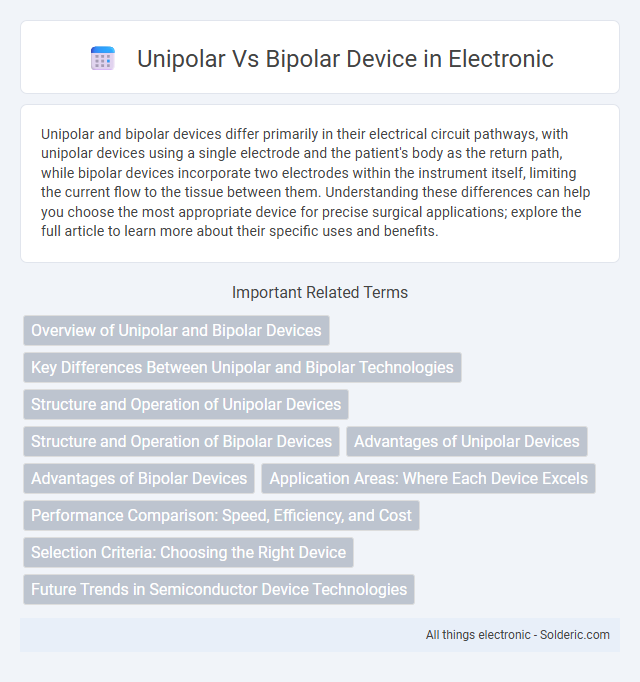Unipolar and bipolar devices differ primarily in their electrical circuit pathways, with unipolar devices using a single electrode and the patient's body as the return path, while bipolar devices incorporate two electrodes within the instrument itself, limiting the current flow to the tissue between them. Understanding these differences can help you choose the most appropriate device for precise surgical applications; explore the full article to learn more about their specific uses and benefits.
Comparison Table
| Feature | Unipolar Device | Bipolar Device |
|---|---|---|
| Electrical Path | Single electrode with grounding pad | Two electrodes close together |
| Current Flow | From active electrode to grounding pad | Between two electrodes |
| Application | Wide tissue areas, large ablation | Precise, localized tissue treatment |
| Risk of Collateral Damage | Higher due to broader current flow | Lower due to localized current path |
| Instrument Size | Typically smaller and simpler | Generally larger, more complex |
| Common Uses | Surgical cutting, coagulation | Neurosurgery, ENT, microsurgery |
| Grounding Requirement | Required | Not required |
Overview of Unipolar and Bipolar Devices
Unipolar devices operate using a single active electrode with the electrical current completing its circuit through a distant return electrode, often resulting in broader energy dispersion. Bipolar devices utilize two closely spaced electrodes within the same instrument, allowing current to flow locally between them, enhancing precision and reducing collateral tissue damage. These fundamental differences impact their applications in surgical procedures, with bipolar devices favored for targeted coagulation and unipolar devices used for cutting and coagulation over larger areas.
Key Differences Between Unipolar and Bipolar Technologies
Unipolar devices utilize a single electrode with a ground pad to complete the circuit, resulting in a broader current flow, while bipolar devices incorporate two closely spaced electrodes, allowing current to pass only between them for more precise energy delivery. Unipolar technology is commonly used in electrosurgery for larger tissue areas, whereas bipolar technology offers enhanced control and reduced collateral damage in delicate procedures such as neurosurgery or microsurgery. The difference in current pathways influences heat dispersion, with bipolar devices minimizing unintended tissue injury through localized energy application.
Structure and Operation of Unipolar Devices
Unipolar devices, such as field-effect transistors (FETs), operate using a single type of charge carrier, either electrons or holes, which flow through a semiconductor channel controlled by an electric field. The structure typically includes a source, drain, and a gate terminal that modulates the conductivity of the channel without involving recombination of carriers. This electric field effect enables low power consumption and high input impedance, making unipolar devices essential in digital switching and amplification applications.
Structure and Operation of Bipolar Devices
Bipolar devices feature a three-layer structure consisting of two types of semiconductor materials, typically N-type and P-type, forming two PN junctions that facilitate charge carrier injection and recombination. Their operation relies on both electrons and holes as charge carriers, enhancing current conduction and enabling higher gain compared to unipolar devices. Common examples include bipolar junction transistors (BJTs), where controlled injection of charge carriers at the base-emitter junction modulates the collector current, enabling amplification and switching functions.
Advantages of Unipolar Devices
Unipolar devices offer advantages such as simpler design and lower power consumption compared to bipolar devices. They enable faster switching speeds due to fewer charge carriers involved in the conduction process, which enhances overall device efficiency. Their reduced complexity also leads to cost-effective manufacturing and increased reliability in electronic circuits.
Advantages of Bipolar Devices
Bipolar devices offer precise energy delivery by confining the electrical current between two closely spaced electrodes, minimizing tissue damage and reducing collateral thermal injury. These devices enhance surgical safety through improved hemostasis and reduced risk of stray current, leading to better patient outcomes and faster recovery times. Their effectiveness in delicate procedures, such as neurosurgery and laparoscopic surgeries, underscores their superiority in controlling bleeding with minimal tissue trauma.
Application Areas: Where Each Device Excels
Unipolar devices excel in applications requiring precise local stimulation, such as deep brain stimulation and cardiac pacing, due to their focused current delivery. Bipolar devices are preferred in environments needing controlled, confined electric fields like neural recording and cochlear implants, minimizing signal interference. Your choice depends on whether targeted stimulation or spatially restricted current flow is essential for optimal performance.
Performance Comparison: Speed, Efficiency, and Cost
Unipolar devices typically offer faster switching speeds and simpler control mechanisms compared to bipolar devices, enhancing performance in high-speed applications. Bipolar devices, while slower, often provide higher current capacity and better thermal stability, which can improve efficiency in power-intensive environments. Your choice between unipolar and bipolar devices should consider the trade-off between cost-effectiveness and operational requirements, as unipolar devices are generally less expensive but may not meet the efficiency demands of all applications.
Selection Criteria: Choosing the Right Device
Selecting between unipolar and bipolar devices depends on factors such as precision, tissue type, and surgical environment. Unipolar devices offer greater versatility and deeper tissue penetration but carry a higher risk of collateral damage, while bipolar devices provide more controlled energy delivery ideal for delicate or blood-rich tissues. Your choice should prioritize the balance between effective coagulation and minimizing thermal spread based on the specific surgical procedure.
Future Trends in Semiconductor Device Technologies
Future trends in semiconductor device technologies emphasize the transition from traditional bipolar devices to unipolar devices due to their higher switching speeds and lower power consumption. Innovations in materials such as silicon carbide (SiC) and gallium nitride (GaN) enhance unipolar device performance, making them ideal for high-frequency and high-voltage applications. Emerging research focuses on integrating advanced unipolar devices with power electronics to support energy-efficient, compact, and high-performance systems in automotive, telecommunications, and renewable energy sectors.
Unipolar vs Bipolar Device Infographic

 solderic.com
solderic.com